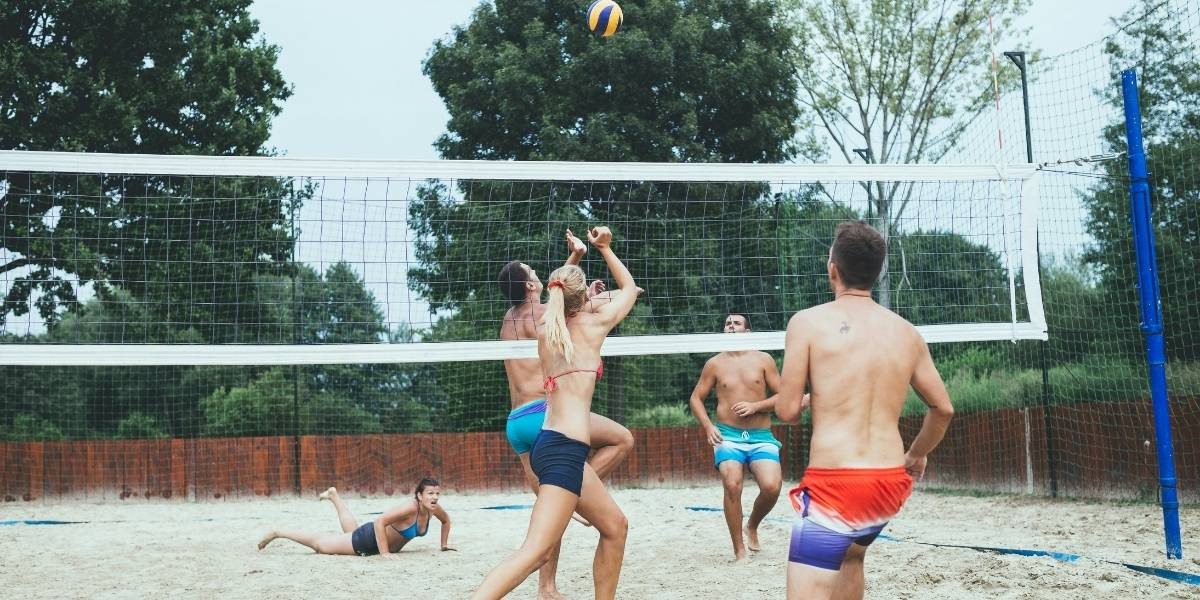Beach volleyball is a sport that perfectly blends athleticism, strategy, and beach culture. Played on sand courts with two-person teams, it combines the thrill of competition with the relaxed, sun-soaked environment of the beach. From its informal origins to its place as a global sport, beach volleyball has captured the hearts of athletes and fans alike. This article explores the vibrant world of beach volleyball, examining its history, techniques, physical demands, and global appeal.
Read Also: Thrilling Horse Racing Events: Top Races & Results
From Shores to Sport
Beach volleyball began as a casual, fun activity on the beaches of Southern California and Hawaii in the early 20th century. What started as a friendly pastime between beachgoers evolved into an organized sport, gaining significant popularity in the 1970s. As the sport grew in stature, it was officially recognized by the International Volleyball Federation (FIVB), and in 1996, it made its debut as an Olympic sport at the Atlanta Summer Olympics.
Key Milestones and Figures
Some of the pivotal moments in beach volleyball’s development include the creation of the first organized tournament in 1965 by Earl “Shorty” Hunt, the formation of the AVP (Association of Volleyball Professionals) in the 1970s, and the rise of legendary players like Karch Kiraly, who has been instrumental in both indoor and beach volleyball’s development. These milestones helped shape the sport into the globally recognized discipline it is today.
The Two-Person Game
Beach volleyball’s unique appeal comes from its two-person format, where athletes must be versatile and proficient in all aspects of the game. Unlike traditional indoor volleyball, where teams are made up of six players, beach volleyball forces each athlete to take on more responsibilities, making the game fast-paced and strategically dynamic.
Teamwork and Communication
In a two-player team, communication and chemistry are key. Teamwork is critical, as each player must cover a significant portion of the court and seamlessly coordinate movements. Unlike indoor volleyball, where specialized roles like setters and liberos exist, in beach volleyball, each player must be capable of serving, passing, setting, and hitting with precision.
Versatility and Adaptability
Players must be able to adapt to different playing situations, as the pace of the game can shift rapidly. Serving requires both power and precision, while passing demands excellent reflexes. Setting on the sand is particularly challenging, as the surface is unstable, and hitting the ball with speed and accuracy requires a great deal of timing and technique.
Mastering the Sand and the Elements
One of the most unique aspects of beach volleyball is the playing environment. Unlike indoor courts, sand presents specific challenges that players must overcome to be successful.
Footwork and Movement
On the sand, players must adjust their footwork and movement to account for the instability of the surface. Quick lateral movements, jumps, and even positioning all become more challenging when playing on sand, requiring athletes to develop specialized agility and balance.
Digging and Setting on an Unstable Surface
Another challenge is digging the ball, which involves diving or low-receiving balls hit hard from the opponent. Since the sand doesn’t provide the solid foundation of an indoor court, players need to practice techniques that allow them to dig effectively. Setting the ball also requires precision, as players must adapt their techniques to account for the shifting sand beneath them.
Dealing with Wind and Sun
The outdoor environment adds another layer of complexity. Wind and sunlight can significantly alter how the game is played. Wind affects ball trajectories, forcing players to adjust their aim and reaction times. Additionally, sun glare can interfere with a player’s ability to track the ball, demanding quick adjustments and resilience.
The Art of Offense and Defense
The dynamics of beach volleyball’s offensive and defensive play are what make the game thrilling. The cat-and-mouse game played above the net involves a variety of strategies aimed at keeping the ball in play and scoring points.
Offensive Strategies: Placement and Precision
On offense, players often rely on shot placement to score. Cut shots, roll shots, and powerful spikes are all techniques used to outmaneuver opponents. A successful offensive strategy involves reading the defense, exploiting weaknesses, and timing shots perfectly.
Defensive Tactics: Blocking and Digging
On the defensive side, the block is a key strategy. Effective blockers use timing and positioning to prevent a spike from crossing the net. However, since there is no back row in beach volleyball, defenders must rely on digging—the act of receiving and controlling the opponent’s attacks. Digging requires reflexes, anticipation, and precise movements to get the ball in the air and keep the rally going.
Physical Demands and Training
Beach volleyball is one of the most physically demanding sports, requiring a combination of speed, strength, and endurance.
Agility and Speed
Players must have incredible agility to quickly move across the sand, adjusting to the unpredictable bounce of the ball. Speed is essential for both offense and defense, as the ball can change direction rapidly.
Jumping Ability and Upper Body Strength
Due to the need to block or spike the ball, players must develop explosive jumping ability. Additionally, the demands of hitting the ball with power require significant upper body strength and core stability. Training for these elements often includes plyometric exercises, strength training, and agility drills.
Endurance and Conditioning
Beach volleyball tournaments often require players to compete in long matches, so endurance and cardiovascular fitness are critical. Players undergo rigorous conditioning routines to build stamina, enabling them to maintain high levels of performance throughout the match.
The Global Beach Volleyball Scene
Beach volleyball has grown into a global sport, attracting players and fans from around the world. Major tournaments and professional tours have expanded the sport’s reach, and its place in the Summer Olympics has significantly increased its visibility.
Professional Tours and Championships
The FIVB World Tour is the premier international professional circuit for beach volleyball. Athletes from across the globe compete for ranking points and the opportunity to win major events like the FIVB Beach Volleyball World Championships. National tours such as the AVP Tour in the U.S. also play a vital role in showcasing top talent and creating opportunities for emerging players.
Olympic Recognition
Since becoming an official Olympic sport in 1996, beach volleyball has gained immense popularity, with countries like Brazil, the United States, and Germany consistently producing top athletes. Olympic competition has further fueled the sport’s global appeal, as players compete not only for medals but also for international recognition.
The Beach Culture and Lifestyle
Beach volleyball is not just a sport; it’s also a lifestyle. The sport has a unique culture that combines athleticism with the relaxed, laid-back atmosphere of the beach.
Outdoor-Oriented and Relaxed Atmosphere
Beach volleyball is often played in open, public spaces like beaches and parks, which fosters a sense of community and connection. The sport’s outdoor-oriented nature encourages participants to enjoy the environment, blending physical exertion with the enjoyment of nature.
A Strong Community Among Players and Fans
There is a strong sense of camaraderie within the beach volleyball community. Both amateur and professional players share a love for the game, creating a close-knit environment where people support one another. Fans of the sport also celebrate the beach lifestyle, attending tournaments and enjoying the atmosphere as much as the competition itself.
Read Also: How Sports Enthusiasts Can Turn Passion into Income
Beach volleyball is an exhilarating, physically demanding sport that combines skill, strategy, and athleticism. From its humble beginnings on the shores of California to its position as a global Olympic sport, beach volleyball continues to grow in popularity and appeal. Whether it’s the challenge of mastering the sand, the excitement of competitive play, or the unique beach culture that surrounds the sport, beach volleyball offers something for everyone.








